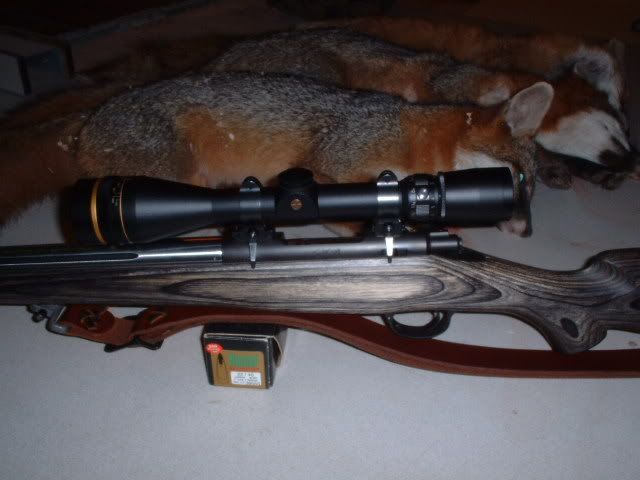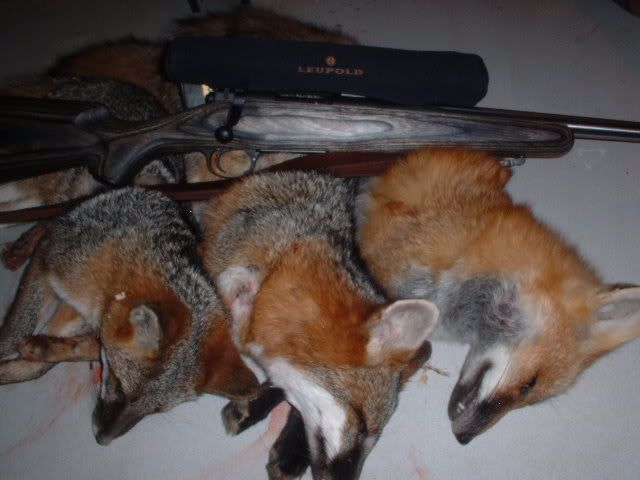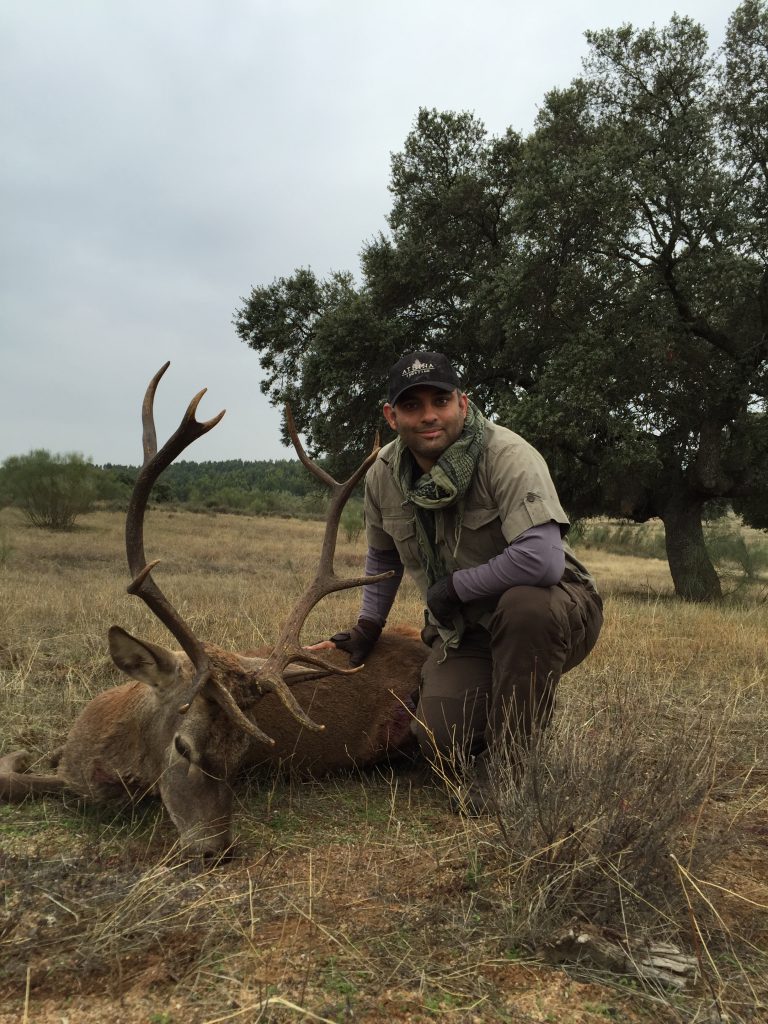

 The Accurate Reloading Forums
The Accurate Reloading Forums  THE ACCURATE RELOADING.COM FORUMS
THE ACCURATE RELOADING.COM FORUMS  Hunting
Hunting  European Big Game Hunting
European Big Game Hunting  Re: Lamping Foxes
Re: Lamping FoxesGo  | New  | Find  | Notify  | Tools  | Reply  |  |
| one of us |
All of the above. I use a red lens filter which I take off when I think the local fox population has got used to it and revert to just ordinary lamplight and swap back again when they become tired of that. Now I have no proof if this works or not as foxes get shot no matter what colour is being used. I think I read it somewhere, started doing it and now it is a habit. I was quite keen on getting a selection of filters at one stage but never got round to it. I have a selection of callers and even a tape recording but I usually end up just squeaking off the back of my hand or a piece of polystyrene on the windscreen. Try them all that's the fun of it, but, just as Pete said do not shoot at eyes only and remember all the usual daylight rules apply. I once had to "dissuade" somebody from taking a shot, there was no back stop and a hot 22-250 was about to launch death into the darkness at about 150yards at a barely discernable fox, it was all too much for me. The strange thing was the shooter would have never taken a shot like that, without a backstop during daylight hours. Just remember that the blackness that you are looking into is just that, blackness, because you cannot see through it does not mean that a bullet will not pass through it. Having said that it is great fun and you can make it as easy or as demanding as you like. Shutting up now. John | ||
|
| one of us |
Deerdogs, one of the main problems we encounter when lamping is lamp shy foxes,even the red filter doesn't stop them legging it, So if you decide to squeeze a round off then make sure its going to kill it, they won't stand a second time!!! We also found that if you squeaked and it ran like the proverbial scalded cat, shouting at it often stopped them long enough for a 120gn of lead. polystyrene makes a good squeaker when dragged across the windscreen. some folk will advocate lighting them directly in the beam some on the periphery of the lamp,we found very little difference, if it stands for a few seconds in the lamp and is in range thats long enough... Shooting in a full moon doesn't help as they can see you, we found the best nights to be black as the ace of spades and slightly drizzly.. good luck Griff p.s don't leave them in the fields it upsets the basil brush fan club. best not to let them know youv'e been!!!! | |||
|
| one of us |
Anyone got any advice on fox lamping tactics? When to use a red filter, when to use a squeeker, does the moon or weather affect things, that sort of thing. I only seem to see foxes at dawn when sitting in a high seat.  | |||
|
| new member |
hi deer dogs most important thing keep right side of the wind keep your light low and just put full on only when your ready to shoot ready to shoot the way foxes will react depends on the amount of lamping activity in your area i always use a red or amber light you can sit out and call on a moonlight nite with shotgun without a lamp or just sit in your highseat and be patient if the wind is rite and your foxes runaway quickly you know somebody has had a crack at them i shot 1 an hour ago after stalking with 7x64 they dont like that much  regards steve regards steve | |||
|
| one of us |
Gentlemen, I apologize for interjecting a Colonial's Perspective into your conversation, however, I find the topic extremely interesting. I've fairly good luck calling both Grey and Red Fox using a JS 612 Caller and Grey Fox Pup Distress Tape. We have a dedicated call/light operator and a shooter. Our opening day was November 1st and we had fair luck. Three shots and three fox. Had I been paying attention that total could have increased by two. To answer your questions: 1. We always use a red filter. Any white light and the stalk is usually over. 2. A full moon with little cloud cover is a bad thing. Typically makes it far more difficult to mask oneself, and/or the vehicle, to the animal. Ideal conditions are no moon or enough cloud cover to make up for it... 3. Be cafefull of assuming which direction the Fox is going to approach from. I've been flanked by more than one large wary fox. Move your light past even unlikely directions of approach. I very nearly had one get in my lap on Monday Evening.(grin) One of the two I did not shoot... 4. Be careful not to "Burn" a Fox by maintaining constant red light contact with his eyes. Use as little of the beam to indicate his position as possible. Full exposure can useful in stopping the fox, however, it does not always work... The rifle is a Kimber Pro Varmint in .223 Remington shooting a 50 grain Nosler Ballistic Tip over a light load of H335 at about 3000 fps. All shots were taken at 75-125 yards on stationary animals. The scope is a Leupold Vari-X III 4.5-14x40 A/O, however, it is due for replacement with a Leupold VX-III 3.5-10x40 with a German No. 4 Reticle. Again I hope my interjection is not an imposition.   Regards, Matt. | |||
|
One of Us |
Deerdogs As you are probably aware spotlighting foxes is a big thing in Australia and was once huge before the greenies destroyed the fox fur coat industry to the great detriment of Australian small native species. A full moon usually means foxes will not stop and will run quicker. Avoid unnecessary talk when afox is seen. They will hear human voices. A fox whistle can be used to bring foxes closer. If they are accustomed to one in the area, its better not to use one. Don't shine the light too much in their eyes. Shine in front of them once they are spotted so the reflected light illuminates them. Then spot them when ready for the shot. If you shine continuely in their eyes they do not like it and may flee. Use a light calibre with fragile bullets. Avoid rimfires which ricochet. The ideal rifle for flat shooting with minimal fur damage if body shots are taken is a .17 using 20 gr or 25 gr HPs. .17s do suffer wind drift though. The bullet should break up if a miss lessening the chance of a dangerous shot. Obviously know the country and what lies behind the target in the dark, whether it is safe such as a hill ortick forest or not as in a cottage or a village. Lambing time is a great time to shoot foxes as they zero in on the flocks. Rivers, ponds and swampy ground during duck nesting time. Farm houses and sheds if they have poultry will bring foxes in every night for a look-see. I also have success shooting them in vine rows in vintage when they eat ripe berries. Maybe not as relevant for you. Also their skins are summer skins and not much use then. Some of the above is pretty basic and you probably are aware of them anyway. Edited: I started this thread an hour ago and had to interrupt it. Missed seeing the post above which has some of the same comments. | |||
|
one of us |
Steve64 is too shy, he is knowing the trick but won�t divulge it. Here in France, nightshooting is fully against the law, it�s the game officers� monopole. As civil servants they rarely (if ever) do it. Have a try, Brigitte Bardot will gut You and any judge would bless her. I learnt (Steve64 as well) in Aboyne Scotland what seems to be a very effective trick. Snare or dig out a cub . Record it�s cry when pinching it�s ear  (caution, the d� thing has sticky fangs). Rig a loudspeaker onto the roof of your car and display the cub�s cry. Aboyne�s gamekeeper are promising this is the most effective trick to lure any fox around. (caution, the d� thing has sticky fangs). Rig a loudspeaker onto the roof of your car and display the cub�s cry. Aboyne�s gamekeeper are promising this is the most effective trick to lure any fox around. | |||
|
| new member |
in reply to my great friend jbderunz comments mondieur je suis not shy i am just to busy practising the ancient childhood art of tree climbing ha ha regards steve | |||
|
| new member |
Gentlemen: Would you please enlighten me to the use of, and what is polystyrene on the windscreen as a varmint call. We use hand calls and are allowed to use electronic calls here, which work quite well. Varmint hunting at night has become a less popular sport, but for the hunters that remain dedicated to the sport it has given us an opportunity, which we haven�t seen in along time. Which means more critters that are not call shy, that you can let the air out of. Thank you, GW | |||
|
one of us |
Hey GaryWW, Polystyerine is just the white hardish plastic used in packaging most allpiances. If you cut a small square of it and drag it accross a peice of glass it will make a squeaking sound. This can be taken by a fox as being a rabbit squealing in a snare and as such charlie coes in to investigate. when he is in range, you are able to administer the general anasthetic and all is fine and dandy. Most calls make a similar sound. Another one is to sandwich a small peice of audio tape in between two bits of balsa wood. so there is a hole in the middle. if you then blow through the hole and over the tape, it makes a greeat call for foxes.... FB | |||
|
| new member |
FB: Thanks for the info, we'll give it try. GW | |||
|
| Powered by Social Strata |
| Please Wait. Your request is being processed... |
|

Visit our on-line store for AR Memorabilia

